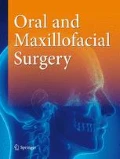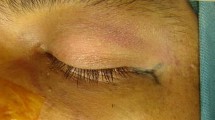Abstract
Introduction
Although some studies addressed the differences between subciliary and transconjunctival approaches, no previous prospective comparative study on displaced zygomaticomaxillary complex (ZMC) fracture that repaired by three-point internal fixation using also upper gingivolabial incision and upper eye lid incision. So, the effect of these incisions on the comparison was not investigated.
Purpose
The purpose of this study was to compare transconjunctival and subciliary approaches for open reduction and internal rigid fixation (OR/IF) of ZMC fractures.
Methods
This prospective study was carried out on 40 patients had displaced ZMC fractures repaired by OR/IF. Patients were randomly assigned into two equal groups (20 patients for each); subciliary group subjected to subciliary approach and transconjunctival group subjected to transconjunctival approach for inferior orbital rim repair. In both groups, frontozygomatic and zygomaticomaxillary buttresses were also approached by lateral eye brow and superior gingivolabial incision, respectively. Primary outcome measures include accessibility (need for lateral canthotomy), the exposure duration, postoperative pain, early postoperative edema, and operative complications. Secondary outcome measures include dental occlusion, average intrinsic vertical mouth opening, post subciliary scar assessment, late postoperative complication, and opthalmological assessment concerning ectropion, entropion, scleral show, and eye globe affection (enophthalmos or diplopia).
Results
The mean duration from incisions to fracture exposure was 13.7 ± 2.17 min in subciliary approach and 14.6 ± 2.31 min in transconjunctival approach with nonsignificant difference (p = 0.1284). Lateral canthotomy was required for proper exposure of the fracture and OR/IF using transconjunctival approach while not needed with subciliary approach. Ectropion and scleral show occurred in 10 and 15% respectively in subciliary group and were not encountered in transconjunctival group. Although postoperative periorbital edema was significantly more sever in transconjunctival group within the first postoperative week (p = 0.028), no persistent periorbital edema was reported. Infection, hematoma, and globe complication were not detected in any patient. All authors characterized all scars of the subciliary group as unnoticeable.
Conclusion
Transconjunctival approach mostly needs lateral canthotomy that was not needed with subciliary approach. Transient postoperative edema is more in transconjunctival approach while postoperative ectropion and sclera show was detected only with subciliary approach. So, building up of experience in transconjunctival approach will be beneficial for maxillofacial surgeons and more measures to avoid ectropion are needed with subciliary approach.
Similar content being viewed by others
References
Kurita M, Okazaki M, Ozaki M, Tanaka Y, Tsuji N, Takushima A, Harii K (2010) Patient satisfaction after open reduction and internal fixation of zygomatic bone fractures. J Craniofac Surg 21:45–49
El-Anwar MW, Elsheikh E, Sweed AH, Ezzeldin N (2015) Electromyography assessment in zygomaticomaxillary complex fractures. Oral and Maxillofacial Surgery 19(4):375–379
Yonehara Y, Hirabayashi S, Tachi M et al (2005) Treatment of zygomatic fractures without inferior orbital rim fixation. J Craniofac Surg 16:481–485
Meslemani D, Kellman RM (2012a) Zygomaticomaxillary complex fractures. Arch Facial Plast Surg 14:62–66
Subramanian B, Krishnamurthy S, Suresh Kumar P, Saravanan B, Padhmanabhan M (2009) Comparison of various approaches for exposure of infraorbital rim fractures of zygoma. J Maxillofac Oral Surg. 8(2):99–102
Ridgway EB, Chen C, Colakoglu S, Bernard TL (2009) The incidence of lower eyelid malposition after fracture repair: retrospective study and meta-analysis comparing subtarsal, subciliary and transconjunctival incisions. Plast Reconstr Surg 124:1578–1586
Gloth FM, Scheve AA, Stober CV, Chow S, Prosser J (2001) The functional pain scale: reliability, validity, and responsiveness in an elderly population. J Am Med Dir Assoc 2(3):110–114
El-Anwar MW, Hegab A (2016) Internal fixation of single mandibular fracture under mandibular nerve block. Oral and Maxillofacial Surgery 20(1):57–61
Meslemani D, Kellman RM (2012b) Zygomaticomaxillary complex fractures. Arch Fac Plast Surg 14:62–66
Zimmermann CE, Troulis MJ, Kaban LB (2006) Pediatric facial fracture: recent advances in prevention, diagnosis and management. Int J Oral Maxillofac Surg 35:2–13
Kovacs AF, Ghahremani M (2001) Minimization of zygomatic complex fracture treatment. Int J Oral Maxillofac Surg 30:380–383
Soejima K, Sakurai H, Nozaki M et al (2009) Semi-closed reduction of tripod fractures of zygoma under intraoperative assessment using ultrasonography. J Plast Reconstr Aesthet Surg 62:499–505
Davidson J, Nickerson D, Nickerson B (1990) Zygomatic fractures: comparison of methods of internal fixation. Plast Reconstr Surg 86:25–32
Parasher A, Sharma RK, Makkar S (2007) Rigid internal fixation of zygomatic fractures: a comparison of two-point and three point fixation. Indian J Plastic surg 40(1):8–24
Santosh BS, Giraddi G (2011) Transconjunctival preseptal approach for orbital floor and infraorbital rim fracture. J Maxillofac Oral Surg 10(4):301–305
De Riu G, Meloni SM, Gobbi R, Soma D, Baj A, Tullio A (2008) Subciliary versus swinging eyelid approach to the orbital floor. J Cranio-Maxillofac Surg 36(8):439–442
Giraddi GB, Syed MK (2012) Preseptal transconjunctival vs. subciliary approach in treatment of infraorbital rim and floor fractures. Ann Maxillofac Surg 2(2):136–140
Manganello-Souza LC, Rodrigues de Freitas R (1997) Transconjunctival approach to zygomatic and orbital floor fractures. Int J Oral Maxillofac Surg 26:31–34
Novelli G, Ferrari L, Sozzi D, Mazzoleni F, Bozzetti A (2001) Transconjunctival approach in orbital traumatology: a review of 56 cases. J Craniomaxillofac Surg 39(4):266–270
Zarem HA, Resnick JI (1991) Expanded applications for transconjunctival lower lid blepharoplasty. Plast Reconstr Surg 88(2):215–220
Author information
Authors and Affiliations
Corresponding author
Ethics declarations
The study was approved by the Institutional Review Board (IRB) at Zagazig University Hospitals and informed consent was signed by all enrolled subjects after explanation of the research purpose.
Financial support
The authors declare no financial support or interest to this study.
Conflict of interest
The authors declare that they have no competing interests.
Rights and permissions
About this article
Cite this article
El-Anwar, M.W., Elsheikh, E., Hussein, A.M. et al. Transconjunctival versus subciliary approach to the infraorbital margin for open reduction of zygomaticomaxillary complex fractures: a randomized feasibility study. Oral Maxillofac Surg 21, 187–192 (2017). https://doi.org/10.1007/s10006-017-0617-2
Received:
Accepted:
Published:
Issue Date:
DOI: https://doi.org/10.1007/s10006-017-0617-2




